
The award, which took place in the Scottish capital on June 23 at the 28th ESACT meeting, recognized the contribution scientists made toward mapping the Cricetulus griseus (Chinese hamster) genome.
Terry Papoutsakis, chemical engineer at the University of Delaware, announced the winning team and presented the award to Michael Betenbaugh from Johns Hopkins University, Nicole Borth from BOKU University, Nathan Lewis from the University of California, San Diego, and Kelvin Lee (not in attendance) from the University of Delaware.
Papoutsakis said that the award recognizes the winners “for transforming biopharmaceutical manufacturing through collaboration and sharing of genomic and associated knowledge that benefits industry and enhances patient access to high quality medicines.”
Betenbaugh described the CHO genome project as a joint effort between academia and industry to improve biomanufacturing production platforms. He discussed the history of using CHO cells in biomanufacturing and the gaps that remained for years before the community committed to mapping a CHO genome.
But before the effort to map the CHO genome, “our cell was a black box,” Betenbaugh said, with untapped potential for improving stability and posttranslational processing. By 2008, processes based on CHO cells were making billions of dollars per year without a genome available.
But some scientists expressed skepticism against further study due to fear of increased regulatory restrictions. “Some people thought we should not even pursue a genome because that would increase the requirements that the government [would impart] on particular companies.”
Betenbaugh said that early efforts were highly fragmented, but a 2010 workshop at Cell Culture Engineering conference in Banff, Canada helped to galvanize the community. “We built upon what we thought should be happening,” he said. Efforts were further supported by academia and funded by a number of private companies such as Genentech, Pfizer, and Amgen. Betenbaugh said that because of such efforts, scientists are able to “understand better what the CHO cell could do and what its capabilities are.”
At the end of his presentation, Betenbaugh asked the audience what innovations were important to tackle next in biomanufacturing. Delegates expressed interest in cell and gene therapies (CGTs), perfusion technology, and adenoassociated viruses (AAVs), but sustainability stood out as the single largest response. At least until it was overtaken during the Q&A session by “a warmer conference room.”
The winners of the ESACT Innovation Award declined to accept a monetary prize of €5,000 (US$5,349) directly and chose to donate it to a patient and public engagement network.
The 2024 ESACT Innovation Award was the third such award presented by the organization after introducing it during its 2019 meeting in Copenhagen, Denmark.
About the Author
You May Also Like





